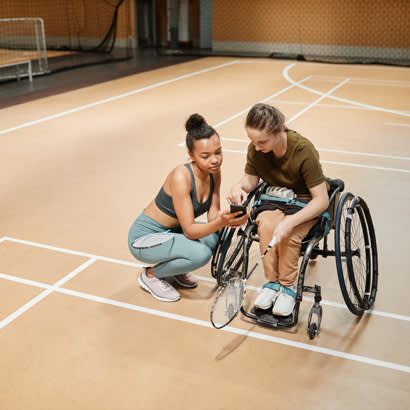
From my vantage point, adaptive sports offerings, especially in southern California, seem to be growing – from the number of adaptive sport non-profits to municipal offerings to college programs. But how do we create greater societal accessibility given how it seems that often, we see ourselves separately from others? Instead of looking for similarities, we see differences, although the DNA of any two human beings is 99.9 percent identical. The fact remains that an estimated 1.3 billion people experience significant disability. This represents 16 percent of the world's population or 1 in 6 people. Disability is part of being human and can occur at any point in our lives. We may become disabled because of an accident or a wartime injury. Some people are born with physical and/or developmental disabilities, and others become disabled as they age. There is no reason why these people should have fewer opportunities to participate in society or engage in activities.
In this work, I’ve found it important to “level the playing field,” by focusing on creating greater societal accessibility and offering numerous opportunities for people with disabilities. This is a social justice issue as noted in UN Development Goal 10 - Reduce Inequality Within and Among Countries. I came to this conclusion as I started working in the field of disability and adaptive sports when I lived in both India and Nepal from 2009-2016. I grew up in Southern California and played a variety of sports. Working with people with disabilities in sports and other activities became my life’s work in 2011.
One of the activities that we engage in is working, encouraging and supporting municipalities to offer adaptive sports. Most municipalities offer a wide range of able-bodied, neuro-typical sports, but adaptive sports tend to be few. Why is this? I’ve heard rationales such as, “We aren’t trained and don’t know how to do this.” Or, “We don’t have court or space availability, given the number of able-bodied offerings.” And even, “We just don’t have time to prioritize adaptive sports.”
To close the gap, we’ve been working on and implementing several programs. One is a bi-monthly Southern California-wide virtual call with several municipalities and organizations interested in offering or already implementing adaptive sports. One long-term goal is for enough municipalities to offer adaptive sports to create multiple adaptive sports teams and leagues throughout Southern California. But we must start somewhere.
Adaptive sports fairs, in which multiple activities are offered, are one way to start. In 2024 we are collaborating with numerous municipalities – Menifee, Burbank, Long Beach, San Diego – and organizations to offer these fairs. They will be successful as municipalities embrace and understand the need for offering adaptive sports and internal champions for adaptive sports are naturally created or hired. Adaptive sports fairs are also a way to build community as everybody is invited to participate.
Another solution is for non-profit organizations offering adaptive sports to partner with municipalities. In Los Angeles, a few different organizations are doing this. We currently partner with the City of Riverside in an after-school youth program once a week and in youth camps during school breaks and in the summer. Through networking, we have also started an after-school program with the City of Rancho Cucamonga and are in discussions to help with programs in Beaumont, Yucca Valley and San Bernardino.
We also offer a school-based program, Sports for everyBODY (SEB), in which we spend time educating and having all children think about disability and experiencing adaptive sports. We’ve been taking a deep dive with Coachella Valley Unified School District (CVUSD) with SEB and now offer regular after-school adaptive sports at multiple locations throughout this district. We are also participating in CVUSD adaptive sport fairs and are offering a parent’s night to create further understanding about adaptive sports.
Experiencing adaptive sports enables those in the able-bodied and neurotypical communities to further understand capabilities. If I have a disability and need to use a wheelchair for mobility and my able-bodied friend also gets into one to play wheelchair basketball and/or other sports, the playing field is leveled. All it takes is a park or gym with a playing surface. This is one way to create greater societal accessibility.
Municipalities truly have the power to level the playing field, creating greater societal accessibility and Sports for everyBODY!
Michael Rosenkrantz is the executive director of SoCal Adaptive Sports. He became involved with adaptive sports in 2011 when he was a VSO volunteer in India, from 2009-11. He is a co-founder of Palms to Pines Parasports dba SoCal Adaptive Sports and served as the organization’s first President. SoCal Adaptive Sports incorporated in May 2020 to address the lack of consistent sports opportunities and to improve the quality of life for persons with disabilities throughout Riverside County and other Southern California communities.


